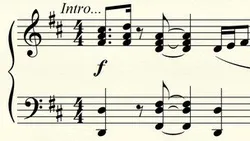
Introduction to Music Symbols (Grade 1 Level 1) 
This lesson introduces students to the basics of music symbols, providing a foundation for learning music as a foreign language. Grade 1, Level 1 provides an introduction to the fundamentals of music notation. ▼
ADVERTISEMENT
Course Feature
![]() Cost:
Cost:
Free
![]() Provider:
Provider:
Udemy
![]() Certificate:
Certificate:
Paid Certification
![]() Language:
Language:
English
![]() Start Date:
Start Date:
On-Demand
Course Overview
❗The content presented here is sourced directly from Udemy platform. For comprehensive course details, including enrollment information, simply click on the 'Go to class' link on our website.
Updated in [February 21st, 2023]
How To Learn Music As A Foreign Language?
What you'll learn:
learn and understand the essential elements of my approach to practice.
readily recognize and identify the different music symbols as the basic foundation in learning music as a foreign language.
learn and understand the five most common types of music notes and rests with their corresponding values.
read and remember the notes on both the treble and bass musical staves.
learn and understand the main function of the grand staff and the leger lines.
learn and understand the basic use and the different types of bar lines and repeat signs.
learn more about how to count the eighth notes and how to group them together
learn and practice the three simple time signatures most commonly used in music.
learn and understand dotted notes, lead-in notes, staccato, legato and ties.
learn and understand the basic components and properties that make musical notes sound pleasing to the ear including dynamics of touch, volume and tempo.
Introduction toMusic Symbols (Grade 1, Level 1) covers the most common symbols and signs used in learning music as a foreign language. The course runs for 1 hour presented as recorded PowerPoint slides covering 10 Sections.
Section 1 answers three very common questions, namely: 1) Why Is Music A Foreign Language?; 2) What Is The Right Approach To Practice?; and 3) How To Maximize Your Learning?
From Section 2 to Section 10, you will be learning the different musical symbols and signs, starting from the musical alphabet, to the musical staff, to the two kinds of clef, the grand staff and leger lines, the names of musical notes and musical rests, simple time signatures, understanding bars and bar lines, lead-in notes, first and second endings, dotted notes, ties, and slurs, and finally, the different dynamic markings and changes in touch, volume and tempo. A few short quizzes and exercises are given to enhance your learning and for actual illustration and demonstration of the lectures covered in the course.
At the end of the course, you shall be able to identify, recognize and understand the different basic musical symbols and signs in the Grade 1 Level but enough for you to start learning how to read music as a foreign language like a real good musician.
(Please note that we obtained the following content based on information that users may want to know, such as skills, applicable scenarios, future development, etc., combined with AI tools, and have been manually reviewed)
Course Overview: Introduction to Music Symbols (Grade 1 Level 1) is a comprehensive course that covers the essential elements of learning music as a foreign language. It covers the different musical symbols and signs, starting from the musical alphabet, to the musical staff, to the two kinds of clef, the grand staff and leger lines, the names of musical notes and musical rests, simple time signatures, understanding bars and bar lines, lead-in notes, first and second endings, dotted notes, ties, and slurs, and finally, the different dynamic markings and changes in touch, volume and tempo.
Possible Development Directions: After completing this course, learners can further develop their music skills by exploring more advanced topics such as music theory, composition, and improvisation. They can also learn to play different instruments and explore different genres of music.
Related Learning Suggestions: Learners can also take advantage of online resources such as YouTube tutorials, music streaming services, and online music communities to further their music knowledge. They can also join music classes or workshops to gain more hands-on experience. Additionally, they can attend music concerts and festivals to gain a better understanding of the music industry.
Pros & Cons

Helpful

Interesting

Easy to understand

Generous instructor

Well presented

Hoping to learn music

Recall school days

Voice not clear

Speak slowly
Course Provider

Provider Udemy's Stats at AZClass
Discussion and Reviews
0.0 (Based on 0 reviews)
Explore Similar Online Courses

Leadership in the Digital Era

Chess Classics You must Know Ep 21 Karpov vs Kasparov Wch 1985 Game 16 The Octopus Knight

Python for Informatics: Exploring Information

Social Network Analysis

Introduction to Systematic Review and Meta-Analysis

The Analytics Edge

DCO042 - Python For Informatics

Causal Diagrams: Draw Your Assumptions Before Your Conclusions

Whole genome sequencing of bacterial genomes - tools and applications

Orchestral Music Composition & Music Theory for Video Games

Music Theory for Songwriters: From Beginner to Producer

Music Theory Level 1: Part Five
 Related Categories
Related Categories
 Popular Providers
Popular Providers
Quiz
 Submitted Sucessfully
Submitted Sucessfully
1. What is the main function of the grand staff?
2. What is the purpose of the course?
3. What are the two kinds of clef?
4. What are the three simple time signatures most commonly used in music?


Start your review of Introduction to Music Symbols (Grade 1 Level 1)